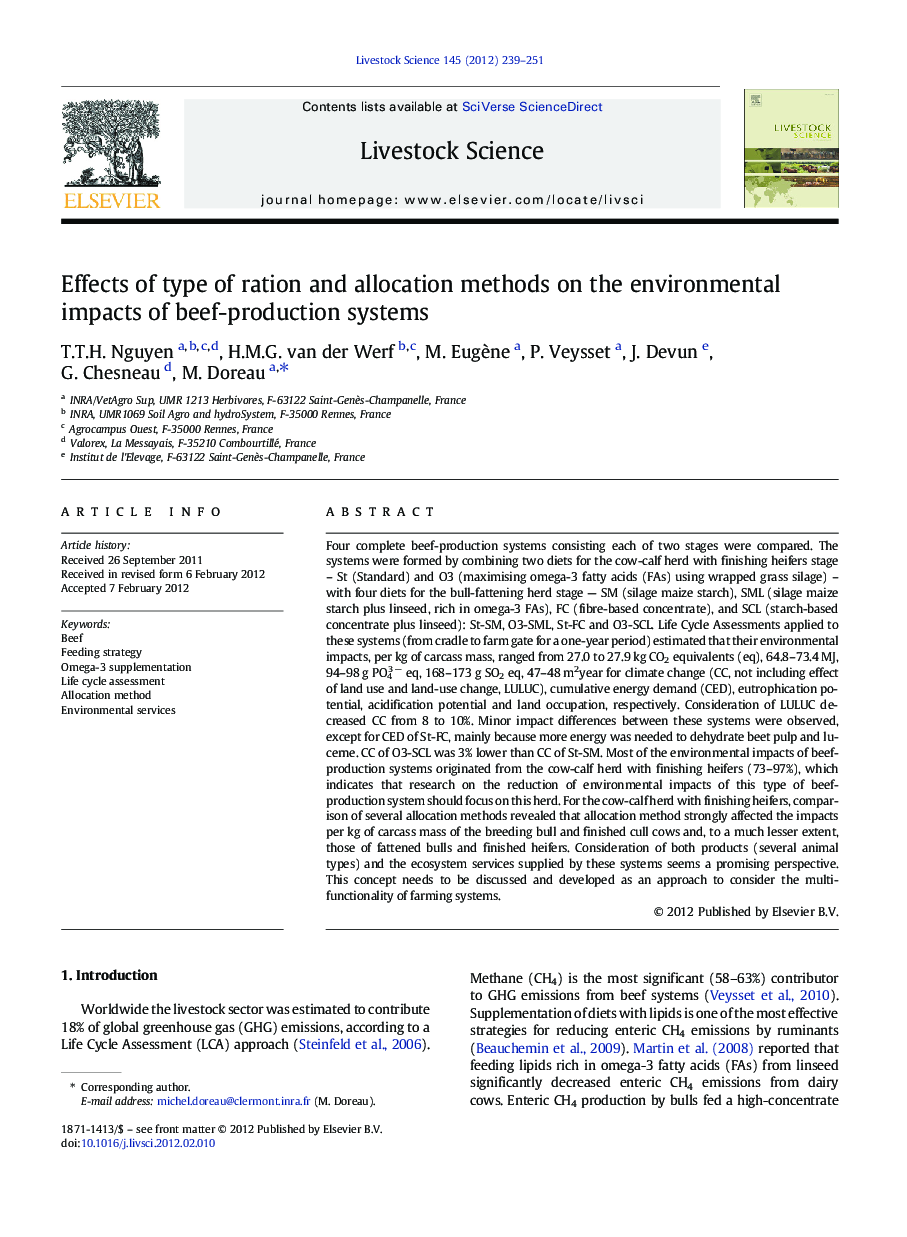| کد مقاله | کد نشریه | سال انتشار | مقاله انگلیسی | نسخه تمام متن |
|---|---|---|---|---|
| 5790586 | 1553987 | 2012 | 13 صفحه PDF | دانلود رایگان |
عنوان انگلیسی مقاله ISI
Effects of type of ration and allocation methods on the environmental impacts of beef-production systems
دانلود مقاله + سفارش ترجمه
دانلود مقاله ISI انگلیسی
رایگان برای ایرانیان
کلمات کلیدی
موضوعات مرتبط
علوم زیستی و بیوفناوری
علوم کشاورزی و بیولوژیک
علوم دامی و جانورشناسی
پیش نمایش صفحه اول مقاله

چکیده انگلیسی
Four complete beef-production systems consisting each of two stages were compared. The systems were formed by combining two diets for the cow-calf herd with finishing heifers stage - St (Standard) and O3 (maximising omega-3 fatty acids (FAs) using wrapped grass silage) - with four diets for the bull-fattening herd stage - SM (silage maize starch), SML (silage maize starch plus linseed, rich in omega-3 FAs), FC (fibre-based concentrate), and SCL (starch-based concentrate plus linseed): St-SM, O3-SML, St-FC and O3-SCL. Life Cycle Assessments applied to these systems (from cradle to farm gate for a one-year period) estimated that their environmental impacts, per kg of carcass mass, ranged from 27.0 to 27.9Â kg CO2 equivalents (eq), 64.8-73.4Â MJ, 94-98Â g PO43Â â eq, 168-173Â g SO2 eq, 47-48Â m2year for climate change (CC, not including effect of land use and land-use change, LULUC), cumulative energy demand (CED), eutrophication potential, acidification potential and land occupation, respectively. Consideration of LULUC decreased CC from 8 to 10%. Minor impact differences between these systems were observed, except for CED of St-FC, mainly because more energy was needed to dehydrate beet pulp and lucerne. CC of O3-SCL was 3% lower than CC of St-SM. Most of the environmental impacts of beef-production systems originated from the cow-calf herd with finishing heifers (73-97%), which indicates that research on the reduction of environmental impacts of this type of beef-production system should focus on this herd. For the cow-calf herd with finishing heifers, comparison of several allocation methods revealed that allocation method strongly affected the impacts per kg of carcass mass of the breeding bull and finished cull cows and, to a much lesser extent, those of fattened bulls and finished heifers. Consideration of both products (several animal types) and the ecosystem services supplied by these systems seems a promising perspective. This concept needs to be discussed and developed as an approach to consider the multi-functionality of farming systems.
ناشر
Database: Elsevier - ScienceDirect (ساینس دایرکت)
Journal: Livestock Science - Volume 145, Issues 1â3, May 2012, Pages 239-251
Journal: Livestock Science - Volume 145, Issues 1â3, May 2012, Pages 239-251
نویسندگان
T.T.H. Nguyen, H.M.G. van der Werf, M. Eugène, P. Veysset, J. Devun, G. Chesneau, M. Doreau,